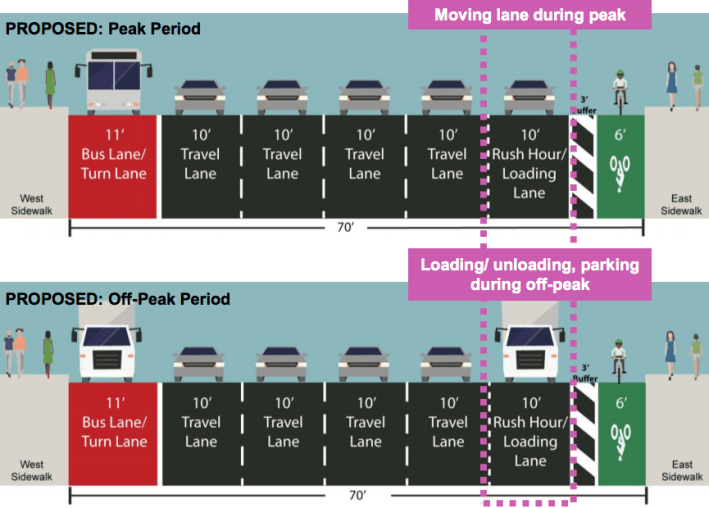One of the scariest stretches for biking on Second Avenue -- the gap in the bike lane approaching the Queensboro Bridge -- is in line for safety improvements from NYC DOT. Like DOT's addition to the Second Avenue bike lane in Midtown, however, much of this nine-block stretch will lack physical protection during rush hour.
DOT presented the plan for Second Avenue between 68th Street and 59th Street to Manhattan Community Board 6 on Monday [PDF]. There was no vote. DOT will also show the plan to CB 8, which includes almost all of the project area, next Monday.
The redesign calls for a buffered curbside bike lane protected by a parking lane during off-peak hours (which the presentation does not specify). But during peak hours, when car traffic is most intense, that parking lane will become a moving lane and there will be no protection.

That's the same treatment DOT gave several blocks of Second Avenue in Midtown, where the bike lane is frequently obstructed as a result, forcing cyclists to weave in and out of motor vehicle traffic. (DOT's presentation argues that on any given block, this stretch of the bike lane is blocked only 3 percent of the time, but looked at as a whole, the data show that someone biking on Second Avenue between 50th Street and 43rd Street during rush hour will probably encounter at least one obstruction.)
Despite the shortcomings of this design, DOT reports that the number of people biking on Second Avenue at 50th Street is up 36 percent since the redesign. But real protection matters: Further north, where the bike lane is protected at all times, cycling is up 105 percent.
The most complex part of the current Second Avenue project is where the bike lane crosses the foot of the Queensboro Bridge. To prevent conflicts between southbound cyclists and drivers heading onto the bridge, DOT splits this block of the bike route into three signal phases. Essentially, cyclists get a dedicated signal phase to cross the path of motorists entering the bridge ("phase 2" below), which means they'll have to wait through one more light cycle than motorists heading south on Second Avenue.
DOT also plans to stripe five crosswalk segments on the east side of the intersection, which currently lacks a pedestrian route, along with the bike markings.
The CB 6 transportation committee declined to endorse DOT's plan on Monday due to concerns about the safety of this part of the design, according to committee member Brian Van Nieuwenhoven. Instead, the committed requested a walkthrough of the area with DOT.
On Monday, DOT also gave an update on the other big, gnarly gap in the Second Avenue bike lane, between 42nd Street and 34th Street by the Queens-Midtown Tunnel. There, the agency is negotiating with the MTA, which operates the tunnel, about how to proceed.
For Monday's DOT presentation to the CB 8 transportation committee meeting, Transportation Alternatives is urging supporters to turn out and support a safer Second Avenue, as well as more complete protection in DOT's bike lane designs. The meeting starts at 6:30 p.m. in Room 615 of Hunter College's West Building, 121 East 67th Street.







